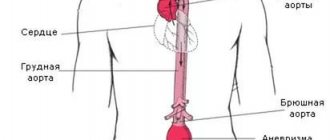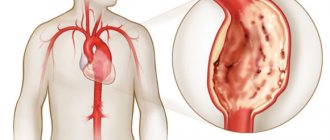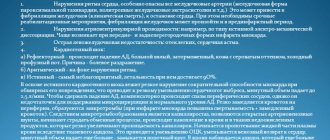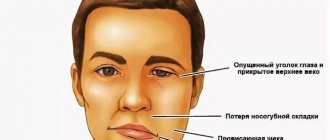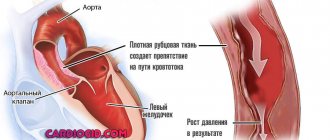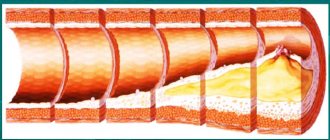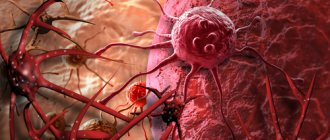Today, according to doctors, diseases of the heart and blood vessels occupy a leading place among all diseases of mankind. The development of cardiovascular pathology, first of all, is caused by a violation of metabolic processes in the body, which occurs under the influence of certain provoking factors.
Disorders of lipid metabolism occur quite often, which leads to the occurrence of such an insidious disease as atherosclerosis, the prevention of which is of great importance for the life and health of mankind.
How to prevent the occurrence and development of atherosclerotic vascular lesions using preventive measures? This memo article is dedicated to this very topic.
Supports normal lipid balance
Before understanding what primary and secondary prevention of atherosclerosis consists of, it is necessary to understand the mechanism of the occurrence of pathology. The primary pathogenetic link in the development of atherosclerotic damage to the vascular network is a disorder of lipid metabolism. This pathological condition manifests itself as a steady increase in the concentration of cholesterol in the blood, which leads to an imbalance between its fractions (the level of HDL decreases, and LDL, on the contrary, increases).
HDL are cholesterol molecules that have antiatherogenic properties. Normally, their serum concentration is quite high, so they prevent LDL from sticking to the endothelial lining of blood vessels in the form of fatty deposits. When hypercholesterolemia occurs, the liver does not have time to process excess cholesterol, and it circulates freely in the bloodstream. A lack of HDL molecules leads to the formation of cholesterol plaques, the structural unit of which is LDL.
Most often, pathology of fat metabolism occurs in old age . However, we should not forget that the risk group includes people who have crossed the threshold of forty years. Therefore, doctors recommend starting primary prevention of vascular atherosclerosis at a young age, when the body’s compensatory capabilities are at a high level. From the age of 30, doctors recommend an annual lipid profile to prevent atherosclerosis. This analysis helps to judge the state of fat metabolism and to identify its slightest disturbances in time.
What is atherosclerosis
Atherosclerosis is a chronic disease caused by the deposition of fats and cholesterol on the inner surface of blood vessels. Over time, connective tissue grows with the formation of fibrous plaques. The process can continue for years. Another feature of the disease is the difficulty of diagnosis in the early stages. Typically, atherosclerosis is detected incidentally when presenting with complaints of weakness, poor health and chronic fatigue. The patient may be asked to check the blood vessels for atherosclerosis by measuring weight, waist circumference and determining blood sugar levels if any of the indicators is above normal.
All causes of atherosclerosis are divided into two groups: primary and secondary. Their combination, severity, possibility or impossibility of elimination affect not only the risk of the disease, but also the treatment process, determination of preventive measures and future prognosis.
Primary causes and factors
The group of primary causes of vascular atherosclerosis includes those that negatively affect health. It could be:
- genetic predisposition;
- active or passive smoking;
- lipid metabolism disorders caused by excess weight or obesity;
- taking drugs;
- violation of the rheological properties of blood;
- alcoholism;
- physical inactivity;
- living in poor environmental conditions;
- unfavorable psychological climate in the family or at work.
An important factor in the development of atherosclerosis is the frequent state of depression, which negatively affects the intima of the media of the carotid arteries.
Secondary causes
Secondary factors include diseases that aggravate the course of atherosclerosis. The most dangerous combination of factors is metabolic syndrome, which is a combination of pathologies of fat and carbohydrate metabolism, as well as the mechanism for regulating blood pressure and endothelial functions. Metabolic syndrome manifests itself in the form of:
- abdominal-visceral obesity;
- hypertriglyceridemia;
- hyperinsulinemia;
- arterial hypertension.
Dyslipidemia and hyperlipoproteinemia may also occur when taking certain medications for diabetes mellitus, nephrotic syndrome, chronic renal failure and hypothyroidism.
Diabetes mellitus is considered a common cause of the development of atherosclerosis, since it provokes a disruption in the production of glucose and lipids with an increase in blood pressure levels. The combination of diabetes and hypertension increases the risk of developing atherosclerosis by 4 times. In diabetes mellitus, lipid metabolism disorder manifests itself in:
- hypertriglyceridemia;
- low HDL levels;
- hypercholesterolemia;
- an increase in the blood volume of small LDL particles of phenotype B.
Secondary causes include viral infections, accompanied by immune and autoimmune reactions, and inflammatory processes. Kidney pathology also becomes a risk factor for the development of the disease, since lipid metabolism disorders manifest as severe hypercholesterolemia or hypertriglyceridemia.
Nutrition rules for vascular health
There is a popular saying: “ We are what we eat .” It carries a deep meaning, because food is a necessary attribute for maintaining the vital activity of all living things. Scientists have repeatedly proven that most diseases occur due to poor nutrition. And atherosclerosis is no exception here. That is why diet or proper nutrition plays a primary role in the prevention of atherosclerosis. In addition, diet correction is a good prevention of thrombosis and vascular diseases, which is based on strengthening blood vessels.
Eat less fast carbohydrates and animal fats
Uncontrolled consumption of fast carbohydrates and fats of animal origin leads to a rapid gain of extra pounds. As is known, excess body weight is one of the most significant factors in the development of atherosclerosis. Animal fats, absorbed in large quantities, are a source of pure exogenous cholesterol, which does not have time to be processed by the liver.
An increase in the concentration of cholesterol in the blood serum leads to its deposition on the internal lining of the vascular network. Over time, the vessels become “clogged” with fatty plaques, which causes circulatory problems in vital organs. To prevent atherosclerosis, you should minimize the consumption of fatty meat, lard, sausages, butter and margarine, fatty sour cream and cottage cheese, and egg yolks.
But we should not forget that meat and dairy products, in addition to fat, are a source of protein. This substance is the basic structural unit of all body tissues. Therefore, it is unacceptable to completely exclude meat and dairy products; you need to choose those that have a small percentage of fat content.
An excess amount of fast carbohydrates in the diet is a heavy load on the pancreas, which is the main regulator of carbohydrate metabolism. In order for sugar to get from the blood into the cells, a biologically active substance is needed - insulin, which is produced by this organ. With an excess of exogenous carbohydrates, there is not enough insulin and the concentration of sugar in the blood remains high. This indicates the development of diabetes mellitus, which is considered an integral companion of atherosclerosis.
Products with trans fats are one of the main risk factors for the development of atherosclerosis
However, carbohydrates are the main source of energy for the body. Therefore, you should not completely abandon them; preference should be given to their “slow” form. Such carbohydrates are found in cereals, durum wheat pasta, whole grain bread, and bran. But eating flour products, baked goods, and sweets should be stopped or reduced as much as possible.
Eat more vegetables and fruits
In order to prevent atherosclerosis, experts recommend eating vegetables and fruits daily. The main component of these products is fiber. Passing through the gastrointestinal tract, these dietary fibers are able to bind excess cholesterol and remove it from the intestines along with waste products.
Fruits and vegetables can be consumed both raw and thermally processed. You should beware of potatoes, large quantities of grapes, bananas - these foods are rich in carbohydrates.
The following vegetables and fruits are ideal for proper nutrition
- beet;
- carrot;
- all types of cabbage;
- tomatoes;
- eggplant;
- bell pepper;
- cucumbers;
- zucchini;
- zucchini;
- apples;
- melons;
- watermelons;
- all types of berries;
- oranges.
Vegetables and fruits can be eaten in their pure form, or they can be used to prepare vitamin-rich salads, freshly squeezed juices, and various dishes. To prevent overeating, you need to focus on the fact that the serving size should be equal to the size of your palm clenched into a fist.
Limit salt intake
Table salt is a seasoning that is used by everyone without exception. It's no secret that salt enhances the taste of food. In excess quantities it has an adverse effect on the body. When consuming large amounts of salt, the endothelial lining of blood vessels becomes loose, which increases the susceptibility of the vascular wall to cholesterol. In order to prevent atherosclerosis of the vessels of the brain and vessels of the lower extremities, it is recommended to consume no more than 8 grams of table salt daily.
Eat foods with antioxidants
A good help in preventing atherosclerosis is the daily consumption of food rich in antioxidants. These include fat-soluble vitamins A and E, as well as water-soluble vitamin PP and vitamin C. These biologically active substances help strengthen the walls of the vascular bed and increase the resistance of the endothelium to lipid deposits.
Synthetic forms of these vitamins can be purchased at the pharmacy, but it is best to eat foods that contain more vitamins and natural minerals. Antioxidants are found in carrots, sea fish, tomatoes, all varieties of cabbage, apricot fruits, orange pumpkin, bell peppers, black and red currants, peanuts, legumes
Consumption of Omega-3 Products
Omega-3 or polyunsaturated fatty acids are another important component that is necessary for the successful prevention of atherosclerosis. These substances increase the elasticity of artery walls, which makes them resistant to the sedimentation of lipid molecules. Sufficient amounts of Omega-3 acids are contained in fatty varieties of sea fish (salmon, mackerel, Atlantic herring, tuna), flax seeds, soybeans, and walnuts.
To protect yourself from atherosclerosis, it is advisable to include these products in your diet at least three times a week.
Healthy lifestyle as a means of prevention
Maintaining a healthy lifestyle will help avoid not only atherosclerosis, but also diseases of the brain, heart, internal organs, musculoskeletal system and mental disorders. The concept of a “healthy lifestyle” includes not only proper nutrition, but also:
- eliminating bad habits;
- psychological climate control;
- compliance with work and rest schedules;
- maintaining physical activity;
- fight against excess or underweight.
It is also necessary to avoid overwork, injury, frostbite or overheating. If there have been cases of atherosclerosis in your family, then it is additionally necessary to include regular examinations and a course of preventive medications.
Reducing cholesterol levels
Cholesterol is a fat-like, soft substance involved in the formation of the cell membrane. It is also necessary for the production of hormones, the synthesis of vitamin D and strengthening the walls of blood vessels. With proteins, fats and other chemical compounds, it moves through the vessels, creating complex compounds - lipoproteins. Cholesterol is divided into bad and good.
Bad is part of low and very low density lipoproteins, and is able to settle on the walls, forming cholesterol plaques. Good cholesterol becomes part of high-density lipoproteins and is transported to body tissues. It has antioxidant and anti-inflammatory properties and prevents the formation of blood clots.
Good cholesterol comes into the body from:
- food (fish, poultry, egg yolk, whole milk and dairy products);
- from internal resources (produced by liver cells).
If LDL and VLDL levels are high, HDL levels need to be increased by:
- physical activity;
- small doses of red wine;
- weight loss;
- giving up trans fats;
- including a large amount of vegetables and fruits in the diet.
Foods that lower bad cholesterol include:
- cereals and cereal flakes;
- beans, eggplants;
- nuts;
- vegetable oil;
- citrus fruits, grapes, avocados, strawberries, physalis, mangoes, apples;
- soy products;
- fatty fish.
Foods lower cholesterol in different ways:
- with the help of dietary fiber, which can bind and remove bad cholesterol before it is absorbed by the intestinal walls;
- with the help of polysaturated acids, which reduce the level of bad cholesterol in the blood;
- using plant stanols and sterols that block the absorption of the substance.
Additionally, to combat cholesterol, medications are prescribed that increase HDL levels and reduce the synthesis of bad cholesterol by liver cells.
To give up smoking
Addiction to cigarettes is one of the main risk factors for atherosclerosis, and nicotine reduces the absorption of many medications. Chronic smoking leads to changes in the body such as:
- narrowing and spasming of blood vessels;
- thinning of the vascular walls, reducing their elasticity and increasing the risk of rupture by 10 times;
- reduction in the volume of the pulmonary lobes.
Nicotine also causes ischemia, heart disease and stroke, and one cigarette smoked increases blood pressure for 15 minutes. Passive smoking is no less harmful - it has a strong effect on the cardiovascular system.
The fight against atherosclerosis includes a mandatory gradual cessation of cigarettes: positive changes begin to appear after 1.5 months. A person breathes easier, headaches go away, blood pressure normalizes, and sleep improves. Quitting smoking also has a positive effect on men's health: the risks of developing impotence are reduced.
Physical activity
Physical inactivity refers to dysfunction of the musculoskeletal system, circulatory, respiratory and digestive systems caused by limited physical activity and a decrease in the force of contraction of muscle tissue.
A sedentary lifestyle leads to:
- weakening of the force of contraction of the heart muscle;
- decreased ability to work;
- decreased tone of blood vessels;
- deterioration of metabolism;
- muscle atrophy;
- vegetative-vascular dystonia;
- endocrine disorders.
Incomplete breakdown of fats reduces the speed of blood flow, which leads to insufficient supply of tissues with nutrients and oxygen. Against the background of physical inactivity, coronary heart disease, obesity, atherosclerosis of the heart and lower extremities, heart failure, etc. quickly develop. Therefore, the prevention of atherosclerosis includes increasing physical activity: doctors recommend swimming, skiing in winter and cycling in summer, walking and walking with Nordic poles, yoga, water aerobics, physical therapy, etc. The load should be uniform and not end in physical fatigue, injury or nervous strain.
The recommended time for exercise is 30-40 minutes a day. It is advisable to exercise daily if you feel well.
Fighting excess weight
Obesity is an increase in body weight due to adipose tissue. It is classified as a chronic disease that can begin at any age and regardless of heredity. Obesity is caused by an imbalance between incoming and expended energy in the body. In the presence of a positive energy balance in the form of physical inactivity and a source of available light calories, triglycerides begin to accumulate in adipose tissue. This negatively affects the condition of blood vessels, HDL levels and blood pressure.
Excess weight can appear as a result of:
- genetic predisposition;
- disorders of the digestive system;
- endocrine diseases;
- psychological eating disorders;
- taking medications;
- stress, depression.
Doctors distinguish several types of obesity:
- abdominal;
- gynoid;
- monstrous;
- Cushingoid;
- cerebral.
The danger of the central or abdominal type lies in the deposition of fat on the abdomen, shoulders, and chest area. This type of pathology has an increased risk of developing heart disease, diabetes, and atherosclerosis. In gynoid obesity, fat accumulates on the abdomen, thighs and buttocks. The Cushingoid type is characterized by the accumulation of fatty deposits in certain areas of the body - this could be the back or face, neck, abdomen, etc. Usually the legs and arms remain thin. The brain type is accompanied by a pathology of the regulatory function of the center of hunger and satiety, and a violation of the release of pituitary hormones. Fat deposits accumulate on the chest, thighs, pubic area and abdomen. The most dangerous type of obesity is monstrous. It is diagnosed when the weight limit is 2 or more times higher than normal. It differs in that the fat hangs in folds, and conventional therapy is ineffective. To treat the pathology, surgical intervention is necessary.
Obesity treatment
The main method of treatment is a rational diet, including a high content of cereals, whole grains, vegetables, nuts, herbs and fruits. To lose weight, you need to constantly monitor calories and take into account physical activity.
The World Health Organization advises calculating your normal daily caloric intake, and then gradually reducing it by 300-550 kcal (per month) to the minimum acceptable energy requirement. For people with low physical activity, the maximum daily caloric content of food consumed should be no more than 2000 kcal.
Additionally, cognitive behavioral therapy is prescribed to psychologically study the causes of overeating. Behavioral therapy is aimed at developing self-control, changing attitudes towards food and eating habits.
Medicines are also used to treat obesity: they provide a short-term effect that may disappear if a person does not follow a diet or increase physical activity. In emergency cases, gastric bypass is prescribed. It consists of surgically dividing the stomach into 2 sections, bringing the small intestine to the small part. After surgery, the patient begins to eat less. At the same time, the absorption of nutrients is reduced due to the movement of food along a short path. Sometimes the banding method is used. Its essence is the application of a silicone ring to the border of the stomach and esophagus. The bandage becomes an obstacle to food, which causes faster satiety. Less commonly used is sleeve gastroplasty - removal of part of the stomach from which a long sleeve is formed. Food passes through it to the intestines.
Physical activity
Treatment and prevention of atherosclerosis includes regular exercise. It’s not for nothing that there is a saying: “Movement is life!” When performing physical exercises, blood flow in all organs accelerates, their perfusion improves, there is an active fight against extra pounds, and metabolism accelerates.
But before you plunge into the world of sports, you should understand a few rules that will help you make the most of physical education. Before you start exercising, you should consult your doctor. At the initial stage, it is necessary to gradually increase physical activity (increase training time and frequency of exercise repetitions).
You should start with classes twice a week, gradually increasing their frequency to five. Before performing the main block of exercises, you need to do a good warm-up - this will help minimize the risk of injury. It is best to give preference to cardio exercises (aerobic type of exercise). These include race walking, running, cross-country skiing, swimming, cycling, and cardio exercises.
Movement is life
Lack of physical activity is a real scourge of modern society. A sedentary lifestyle, refusal to walk in the fresh air, use of an elevator instead of stairs lead to the fact that the body does not produce the necessary biologically active substances that protect the vascular wall and increase the amount of lipoproteins responsible for transporting cholesterol for disposal. It has been proven that regular physical exercise reduces mortality by a third. To prevent atherosclerosis, an excellent solution would be activities such as brisk walking, light jogging, cycling, swimming, skiing, etc. Ideally, for good health, you should exercise for 35–40 minutes a day continuously. But here it is important to monitor your heart rate - it should be 65–70% of the maximum norm recommended at a given age. You can calculate your maximum using the formula 220 - age (in years).
Article on the topic
An insidious blood clot. When is it useful and when is it dangerous?
For those who already have any cardiovascular problems, physical activity in intensity and duration should be selected individually and based on examinations.
Quitting bad habits and normalizing weight
The most important factors that increase the likelihood of developing vascular atherosclerosis are considered to be addictions and the presence of extra pounds. Smoking tobacco and hookah, regular consumption of alcohol, chronic stress have a detrimental effect on the state of metabolism. Regular overeating over time leads to obesity, which is the cause of many diseases, including atherosclerosis.
Therefore, recommendations for prevention and how to avoid atherosclerosis are primarily based on lifestyle correction. To this end, it is necessary to completely abandon addictions, bring your weight to normal (according to BMI), and maintain the correct daily routine. Losing extra pounds is possible with proper nutrition and adequate physical activity.
Types and symptoms of atherosclerosis
Atherosclerosis can affect arteries throughout the body, which affects the symptom complex associated with the disease. In medicine, depending on the location of damaged vessels, the following types are distinguished:
- Brain and carotid arteries. This disease is called chronic cerebral atherosclerosis, which can develop asymptomatically over several years, and at some point manifest itself as an ischemic or hemorrhagic stroke. Accompanied by: headaches, difficulty concentrating and remembering, deterioration of brain activity, disturbance of speech centers, frequent dizziness and high blood pressure.
- Lower extremities, called obliterating atherosclerosis. Poor blood supply to the legs affects: sharp pain in the fingers, chilliness, pale skin and cramps. Also, the pulse cannot be felt in the artery under the knee and on the ankle.
Atherosclerosis of the vessels of the lower extremities
- Intestines, called mesenteric atherosclerosis. This pathology is fraught with complete blockage of the intestinal vessels, which without timely treatment leads to the death of the patient. The first symptoms of the disease appear in the form of: bowel problems (prolonged constipation), severe abdominal pain, weakness, cold sweat and difficulty bowel function.
Video: atherosclerosis of intestinal vessels:
- Heart (coronary arteries). Damage to these vessels by cholesterol plaques leads to ischemic heart disease (coronary heart disease), angina pectoris, and myocardial infarction. Signs of atherosclerosis of the coronary arteries are: sharp pain in the sternum of a compressive nature, which occurs as a result of physical or psycho-emotional stress; weakness; low pressure; pain in the heart area that is not responsive to medications.
- Kidneys, which is fraught with the development of hypertensive disease in a malignant form. Atherosclerosis of the renal arteries tends to manifest itself as pain in the lumbar region and darkening of the urine with the possible appearance of blood in it.
- Fundus. This disease is characterized by the presence of floating spots and the exclusion of some fragments from the field of view.
- Aorta. This atherosclerosis is accompanied by a sharp decrease in pressure, intense pain in the upper abdomen that does not respond to medications, rapid pulse, and cold sweat.
If such signs of atherosclerotic vascular damage occur, you should consult a doctor who will help identify the disease and begin treatment in a timely manner.
Important! Atherosclerotic damage to the body's vascular system can lead to complications such as gangrene, arterial thrombosis, heart attack or stroke.
Visiting the bathhouse and sauna
Among preventive measures in the fight against atherosclerosis, visiting a bathhouse or sauna plays an important role. Since ancient times, bath procedures have been famous for their healing properties. Their essence is to strengthen the vascular wall by exposing the body to contrasting temperatures.
Treatment with high and low temperatures is one of the sections of biohacking
A hot steam room helps relax and dilate blood vessels, thereby increasing blood circulation in all organs and tissues, which prevents ischemia. Ice water, which is poured over after leaving the steam room, on the contrary, causes vasospasm. Alternating bath procedures trains the walls of the vascular bed, making them more elastic. The sauna has the same effect. Massage with an oak or birch broom further improves microcirculation, increases blood flow, and promotes the removal of metabolic products through the skin pores - this is a reliable prevention of skin aging.
During trips to the bathhouse and sauna, drinking alcohol is strictly prohibited - this can cause a vascular accident. Beginners should not immediately go into the steam room for a long time. The time spent there should be increased gradually, as the body gets used to such a load. Such prevention of atherosclerosis will bring not only benefits, but also a lot of fun!
Soviet medical scientist, Doctor of Medical Sciences. Author of innovative techniques in cardiology and thoracic surgery.
Where does atherosclerosis come from?
Healthy arteries in a young body do an excellent job of their purpose. They are needed to carry blood traffic from head to toe, so that every corner of the body has oxygen and necessary nutrients.
It happens that the owner moves little in the fresh air or smokes, or eats excess food of animal origin and at the same time gets nervous. The entire arterial system is going through difficult times: very little oxygen is supplied; metabolism slows down, and excess fats from the intestines have to be transported back and forth, because nowhere in the organs is so much fat needed.
And if a person also smokes, swears, is afraid, and worries constantly, then the lumen of each blood “tunnel” narrows. This makes blood flow difficult.
Now, if all the streets of the city are narrowed to one lane, then there will be interruptions in the delivery of food and water, timely meetings of responsible people will not take place, and the well-being of the city will be at risk.
It's the same with the human body. Hormones or immune cells that do not arrive on time will lead to an incorrect response and the onset of various diseases.
At the micro level, the following events occur:
- First, excess cholesterol and a lot of other unnecessary unclaimed fat molecules rush through the narrowed (temporarily) arteries, then they begin to “stick” to the walls of the vessels from the inside, penetrate under the lining of the vessel, but then the path is closed to them.
- Further, fatty deposits grow along the walls of the vessels. These deposits change the shape of the vessel, especially the internal lumen.
- For each such accumulation of fat, connective tissue is produced, which tries to restrain the growth of fatty deposits and strengthen the exfoliated and fragile wall.
- Unfortunately, this is not enough to return the arteries to their original state; now they are permanently narrowed, and the further they go, the worse.
- The blood flow is forced to overcome obstacles and be late to its destination.
- The target organs experience hunger and lack of oxygen, perform their functions poorly and begin to lose strength.
Secondary prevention of atherosclerosis
From the information presented above, the conclusion follows that primary prevention of atherosclerosis is a set of measures, the implementation of which helps prevent the occurrence and development of the disease. Secondary prevention is carried out when the disease is confirmed using a set of diagnostic procedures.
In such cases, the attending physician prescribes prophylaxis with medications along with dietary correction and regular physical activity. In order to inhibit the progression of atherosclerosis, patients are prescribed drugs that reduce serum cholesterol levels. These include statins, fibric acid derivatives, and drugs based on anion exchange resins.
Atherosclerosis is a pathology that occurs in most cases due to poor lifestyle choices. Its timely correction is the best prevention of the disease.
Like any disease, it is easier to prevent atherosclerosis in time than to then fight it for life - so preventive measures will become a reliable assistant in this!
Overview of preventive measures
Primary prevention includes changing lifestyle, diet, giving up bad habits, and moderate physical activity.
Secondary prevention involves taking medications to eliminate arterial hypertension, normalizing blood lipid levels, and taking antiplatelet agents to thin the blood to prevent the formation of blood clots.
It is necessary to prevent and prevent further development of the pathological process. Atherosclerosis is a dangerous disease that requires timely measures.
Medicines
Taking medications is aimed at reducing blood cholesterol and stopping the growth of atherosclerotic plaques with insufficient dietary adjustment.
| Group of drugs, pharmacological action, representatives. | Side effects and contraindications |
| Statins lower blood cholesterol levels and block its production by liver cells. Simvastin, Miscleron, Simvastatin. | Migraines, bowel movements, nausea, insomnia. Pregnancy, lactation, liver and endocrine system diseases, allergies to drug components. |
| Fibrates accelerate the breakdown of fats from atherosclerotic plaques. Fenofibrate. Ciprofibrate. | Migraines, bowel movements, nausea, insomnia, anemia. Pregnancy, lactation, gallbladder and kidney diseases, allergies to drug components. |
| Fatty acid sequestrants prevent the absorption of cholesterol from the intestine. Beta-Sitosterol, Cholestyramine. | Diarrhea, constipation, nausea. Pregnancy, lactation, allergic reactions. |
| Nicotinic acid and its derivatives stimulate lipid metabolism and accelerate the breakdown of fats. | Redness and a feeling of heat, the formation of stones in the bile ducts, an increase in blood glucose. Pregnancy and lactation, gout, allergic reactions. |
The information is provided for informational purposes only. Take these medications as prescribed by your doctor. We recommend reading
- Causes of atherosclerosis formation
- How to take flax oil for blood vessels
- What to eat for atherosclerosis
Folk remedies
The action of traditional methods is aimed at reducing cholesterol levels, cleansing blood vessels, and removing cholesterol plaques. Home remedies are measures to prevent atherosclerosis; they cannot be used for treatment. In the summer, take baths with fresh nettle - a good way to prevent the development of obliterating atherosclerosis of the lower extremities.
| Ingredients and method of preparation | Expected Efficiency |
| Hawthorn fruits – 50 pcs., water – 100 ml. Pour the raw material with water, heat to 50°, leave for 30 minutes. | Cleansing blood vessels, thinning the blood. |
| Rose hips - 2 tsp, water - 1 cup. Infuse rose hips in boiled water. | General strengthening agent, enhancing immunity, preventive measure. |
| Thyme – 1 tsp, water – 1 glass. Prepare a decoction. | A general tonic, prevents vascular spasms, improves blood circulation. |
| Medium size potatoes – 1 pc. Grate and collect the juice with gauze. | Reduces cholesterol, improves the functioning of brain vessels and cerebral circulation. |
| Honey, lemon juice, purified vegetable oil - in equal proportions. Mix the ingredients. Take in the morning on an empty stomach. | Improving blood circulation, normalizing vascular function, helps prevent atherosclerosis. |
| Melissa – 1 tsp, water – 1 glass. Make a decoction. | General strengthening agent. Effective for stress and nervous experiences. |
| Dry white or red wine - 1 bottle, ginger, cardamom, cloves, nutmeg, orange zest - 1 pinch, sugar syrup - 0.5 cups. Mix the ingredients. | A remedy for strengthening the immune system, helps with headaches and dizziness. |
| Rose hips, rowan leaves, strawberries (1 tsp each), water - 500 ml. Prepare a decoction. | A preventative measure against blockage of blood vessels, a general tonic. |
Do not use home remedies if you are allergic to recipe ingredients.
What information is missing from the article?
- Detailed review of medications
- More practical treatments
- Innovative developments in this area
- Qualified expert opinion
Nutrition
The principle of nutrition for the prevention of atherosclerosis is to avoid fatty, fried foods. The best way is steaming. You can avoid vascular atherosclerosis if you eat more often, but in small portions.
Introduce into your diet:
- porridges and low-fat soups,
- use vegetable oils not for frying, but for adding to salads and porridges,
- legumes,
- nuts, dried fruits,
- fresh vegetables, fruits,
- drink liquids - at least 2 liters per day in any form (teas, compotes, distilled water). Do not drink carbonated sweet drinks,
- seafood,
- bran,
- spices: garlic, onion, turmeric,
- greenery,
- boiled fish, lean meat,
- fish fat.
Eat dairy products, eggs, and butter in moderation. Consumption of flour products should be reduced, but not eliminated. It is better to consume baked goods made from rye flour.
Remove from your diet:
- fast food,
- sausages, sausages,
- animal fats (lard, fatty meat),
- refined sugar,
- canned foods with high salt content,
- strong tea, coffee,
- alcoholic products,
- smoked meat,
- fried foods,
- mayonnaise,
- margarine,
- sauces, ketchups.
Physical exercise
This is a necessary component of anti-sclerotic prevention. Doing sports without fanaticism helps to cope with the following complicating factors:
- Conquer obesity;
- Stop the progression of diabetes;
- Helps cope with nervous overload;
- Conquer arterial hypertension.
Reasons and factors
The formation of atherosclerotic changes in blood vessels is influenced by various factors, which can be divided into primary and secondary. The primary mechanisms for the formation of atherosclerosis are:
- Accumulation of uric acid crystals in the body (gout);
- Systematic increase in blood pressure (hypertension);
- Disorders of carbohydrate metabolism, including diabetes mellitus types 1 and 2;
- Acute and chronic kidney diseases accompanied by uremia;
- Underfunction of the thyroid gland (hypothyroidism).
The so-called secondary factors in the formation of atherosclerotic plaques represent an entire system that consists of dietary habits, the presence or absence of bad habits, as well as other aspects of a person’s lifestyle. Secondary factors in the formation of atherosclerosis include:
- Drinking alcohol and smoking;
- Excessive content or deficiency of vitamin D, B12, B6 and folic acid in the body;
- Excessive consumption of fatty, fried and spicy foods, as well as various fast foods and processed foods;
- Excess body weight;
- Sedentary lifestyle (hypodynamia);
- Long-term use of hormonal contraceptives;
- Advanced age;
- Regular exposure to stress on the body, emotional and physical stress;
- Violation of the functional state of the liver, resulting in increased production of endogenous cholesterol.
In addition, gender is a predisposing factor for the occurrence of atherosclerosis. Representatives of the male population have an increased risk of atherosclerosis of the lower extremities, brain and heart.
What is possible and necessary
Do not be upset by the large list of recommended restrictions on the menu for the prevention of arterial atherosclerosis. The number of food products that are allowed to be used for preparing dishes also corresponds to a wide list.
How can you replace harmful ingredients, how to avoid atherosclerosis? Instead of refined sugar, it is recommended to use honey or cane sugar. Dairy products are best consumed in low-fat form. Preference is given to bread made from whole grain flour and cereals made from unprocessed grains. At first it will seem that the taste of such food is specific, but over time you can get used to it.
Permitted products include the following:
- vegetables and fruits (350-400 g/day);
- lean meats (veal, turkey, rabbit, chicken);
- any fish;
- porridges containing fiber (bran, oatmeal, buckwheat, pearl barley, millet);
- nuts (peanuts, walnuts);
- seaweed (if the patient does not have thyroid damage);
- drinks with chicory.
If possible, you should eat large amounts of fish, even replacing meat products with it. Fatty varieties, especially sea varieties, contain a lot of polyunsaturated fatty acids (omega-3). They help improve the nutrition of cells and tissues of the body and participate in metabolic processes.
Omega-3 prevents the development of atherosclerosis by lowering cholesterol levels in the blood.
Vegetables and fruits can be eaten in unlimited quantities. It is best to choose those that have low sugar levels. These include cucumbers, cabbage, apples, oranges, beets, and tomatoes.
Reducing the level of “bad” cholesterol can be achieved by including garlic in your diet.
Adding spices such as ginger, onion, garlic, coriander, turmeric helps normalize lipid metabolism in the body. Another advantage of seasonings is their spicy taste. By combining them, you can create masterpieces of culinary art that are healthy for the whole family. But there must always be a measure. Excessive consumption of spices can lead to the development or recurrence of digestive diseases.
You should not use mayonnaise for dressing salads or making sauces. It can be replaced with more useful substances: add low-fat yoghurts or vegetable oils. Unrefined oils (linseed, olive, sunflower) are sources of omega-6 fatty acids. They also help fight cholesterol deposition on the walls of blood vessels during atherosclerosis.
Atherosclerosis: prevention and treatment, general information
Prevention of atherosclerosis requires constant efforts of the entire healthcare system (Table 242.2). The activities of individual doctors and medical institutions should be aimed at eliminating risk factors even before symptoms appear. The doctor needs to examine all his patients for risk factors for atherosclerosis and take measures to reduce this risk: conduct conversations about the dangers of smoking and help quit smoking, recommend a balanced diet and sufficient physical activity to maintain an ideal weight. For obesity, especially male type. Glucose tolerance decreases, atherogenic dyslipoproteinemia occurs. hypertriglyceridemia and decreased HDL levels. It is necessary to encourage the patient’s desire to get rid of avoidable risk factors. Conscientious implementation of preventive measures can delay the use of drugs and reduce their doses.
Prevention of atherosclerosis includes treatment of arterial hypertension. if necessary, medication.
Primary prevention
Primary prevention of the development of vascular atherosclerosis should include reducing or eliminating risk factors identified in the patient. It has the following directions:
- rational and balanced nutrition;
- normalization and maintenance of optimal body weight;
- healthy lifestyle;
- moderate physical activity.
Focusing on these criteria helps keep the heart and blood vessels in good shape and fight the development of the disease. Following simple recommendations from an early age allows a person to remain young and healthy for many years.
Proper nutrition
It is quite difficult to change your usual diet in order to prevent vascular atherosclerosis. Organizing proper nutrition requires a certain amount of patience and willpower.
The weekly menu should be compiled individually, taking into account the patient’s gender, age, general well-being, concomitant pathology, weight indicators, characteristics of the level of physical activity, and the stage of development of atherosclerosis.
General standards of proper nutrition should include the following points:
- fractionalization (from 5 times/day);
- high quality food;
- compliance with a person’s daily needs for fats, carbohydrates, proteins;
- required energy value;
- limiting salt intake;
- eating food in small portions (up to 300 g at a time);
- sufficient drinking regime (up to 1.5 liters of liquid per day).
Compliance with the principles of proper nutrition allows you to normalize the level of total cholesterol in the blood. This reduces the risk of developing vascular atherosclerosis.
Description
A little about the disease itself and its dangers.
This disease is considered by doctors to be the main cause of the vast majority of cardiovascular pathologies. As a result of the development of atherosclerosis, fatal diseases such as myocardial infarction, stroke and others appear.
Atherosclerosis itself is, in simple terms, the aging of blood vessels. As a result of contamination of the bloodstream, their walls become less elastic, thinner, and deposits of the famous “cholesterol plaques” appear inside the vessels. Because of these deposits, the lumen of the vessels becomes smaller and may even close off completely, which will inevitably lead to dire consequences.
Problems with blood vessels most often begin in old age, less often in middle age. This happens due to the natural aging of the body, along with which, of course, the blood vessels also age. Treatment of pathology is expensive not only in terms of finances: the disease also significantly reduces a person’s quality of life, imposes its own limitations, and sometimes forces one to give up a career and active work.
Therefore, prevention of atherosclerosis is the best solution to avoid the disease and all the troubles associated with it.
Traditional medicine to help blood vessels
Preventive measures for atherosclerosis using folk remedies of natural origin have virtually no side effects. Before using any folk recipe, you still need to consult with your doctor so as not to cause harm. Moreover, drug treatment should not be replaced only with decoctions and grandmother’s recipes.
Traditional medicine is natural, has an affordable price and a significant effect. Most often in the prevention of atherosclerosis, infusions, decoctions of herbs, seeds, vegetables, and honey are used. Some tinctures are made with alcohol. Traditional methods:
- tincture of hawthorn fruits, recommended for older people, tones blood vessels;
- rosehip infusion, a storehouse of vitamins and nutrients, slows down the aging process of the body;
- thyme tincture to destroy microbes, boost immunity, and fight heart spasms;
- honey has a tonic and bactericidal effect;
- potato juice in the morning cleanses and strengthens blood vessels;
- a mixture of lemon juice, honey and vegetable oil, if you are not allergic to the components;
- lemon balm tea helps with insomnia, dizziness, and excitability;
- baths with fresh nettle for atherosclerosis of the vessels of the lower extremities;
- alcohol tincture of vodka sophora has anti-sclerotic properties.
To prevent atherosclerotic processes, the measures listed should become a way of life; a one-time implementation will not help. Proper nutrition and regular exercise will help counteract atherosclerosis and keep the walls of blood vessels in good shape. Everything becomes a habit when done regularly for 30 days. The recommendations are simple, but effective. It is easy to get used to the right lifestyle and make it part of your normal daily routine.
